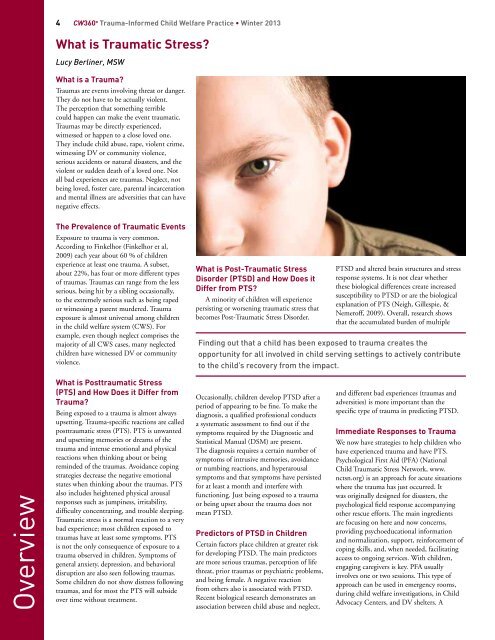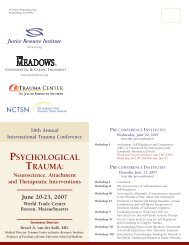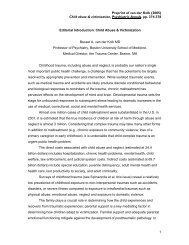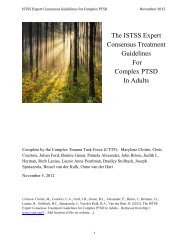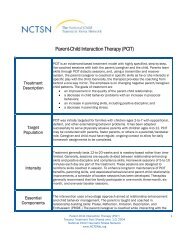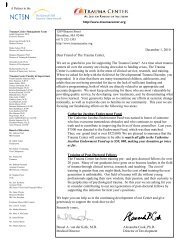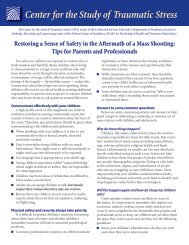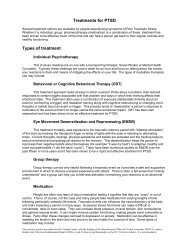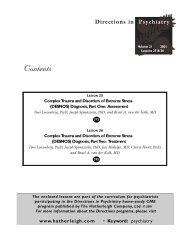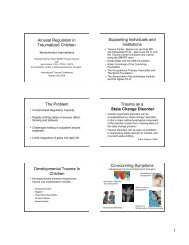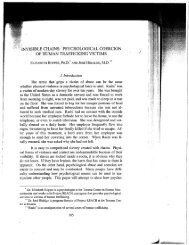in Child Welfare - The Trauma Center
in Child Welfare - The Trauma Center
in Child Welfare - The Trauma Center
Create successful ePaper yourself
Turn your PDF publications into a flip-book with our unique Google optimized e-Paper software.
4 CW360 o <strong>Trauma</strong>-Informed <strong>Child</strong> <strong>Welfare</strong> Practice • W<strong>in</strong>ter 2013What is <strong>Trauma</strong>tic Stress?Lucy Berl<strong>in</strong>er, MSWWhat is a <strong>Trauma</strong>?<strong>Trauma</strong>s are events <strong>in</strong>volv<strong>in</strong>g threat or danger.<strong>The</strong>y do not have to be actually violent.<strong>The</strong> perception that someth<strong>in</strong>g terriblecould happen can make the event traumatic.<strong>Trauma</strong>s may be directly experienced,witnessed or happen to a close loved one.<strong>The</strong>y <strong>in</strong>clude child abuse, rape, violent crime,witness<strong>in</strong>g DV or community violence,serious accidents or natural disasters, and theviolent or sudden death of a loved one. Notall bad experiences are traumas. Neglect, notbe<strong>in</strong>g loved, foster care, parental <strong>in</strong>carcerationand mental illness are adversities that can havenegative effects.<strong>The</strong> Prevalence of <strong>Trauma</strong>tic EventsExposure to trauma is very common.Accord<strong>in</strong>g to F<strong>in</strong>kelhor (F<strong>in</strong>kelhor et al,2009) each year about 60 % of childrenexperience at least one trauma. A subset,about 22%, has four or more different typesof traumas. <strong>Trauma</strong>s can range from the lessserious, be<strong>in</strong>g hit by a sibl<strong>in</strong>g occasionally,to the extremely serious such as be<strong>in</strong>g rapedor witness<strong>in</strong>g a parent murdered. <strong>Trauma</strong>exposure is almost universal among children<strong>in</strong> the child welfare system (CWS). Forexample, even though neglect comprises themajority of all CWS cases, many neglectedchildren have witnessed DV or communityviolence.What is Post-<strong>Trauma</strong>tic StressDisorder (PTSD) and How Does itDiffer from PTS?A m<strong>in</strong>ority of children will experiencepersist<strong>in</strong>g or worsen<strong>in</strong>g traumatic stress thatbecomes Post-<strong>Trauma</strong>tic Stress Disorder.PTSD and altered bra<strong>in</strong> structures and stressresponse systems. It is not clear whetherthese biological differences create <strong>in</strong>creasedsusceptibility to PTSD or are the biologicalexplanation of PTS (Neigh, Gillespie, &Nemeroff, 2009). Overall, research showsthat the accumulated burden of multipleF<strong>in</strong>d<strong>in</strong>g out that a child has been exposed to trauma creates theopportunity for all <strong>in</strong>volved <strong>in</strong> child serv<strong>in</strong>g sett<strong>in</strong>gs to actively contributeto the child’s recovery from the impact.OverviewWhat is Posttraumatic Stress(PTS) and How Does it Differ from<strong>Trauma</strong>?Be<strong>in</strong>g exposed to a trauma is almost alwaysupsett<strong>in</strong>g. <strong>Trauma</strong>-specific reactions are calledposttraumatic stress (PTS). PTS is unwantedand upsett<strong>in</strong>g memories or dreams of thetrauma and <strong>in</strong>tense emotional and physicalreactions when th<strong>in</strong>k<strong>in</strong>g about or be<strong>in</strong>grem<strong>in</strong>ded of the traumas. Avoidance cop<strong>in</strong>gstrategies decrease the negative emotionalstates when th<strong>in</strong>k<strong>in</strong>g about the traumas. PTSalso <strong>in</strong>cludes heightened physical arousalresponses such as jump<strong>in</strong>ess, irritability,difficulty concentrat<strong>in</strong>g, and trouble sleep<strong>in</strong>g.<strong>Trauma</strong>tic stress is a normal reaction to a verybad experience; most children exposed totraumas have at least some symptoms. PTSis not the only consequence of exposure to atrauma observed <strong>in</strong> children. Symptoms ofgeneral anxiety, depression, and behavioraldisruption are also seen follow<strong>in</strong>g traumas.Some children do not show distress follow<strong>in</strong>gtraumas, and for most the PTS will subsideover time without treatment.Occasionally, children develop PTSD after aperiod of appear<strong>in</strong>g to be f<strong>in</strong>e. To make thediagnosis, a qualified professional conductsa systematic assessment to f<strong>in</strong>d out if thesymptoms required by the Diagnostic andStatistical Manual (DSM) are present.<strong>The</strong> diagnosis requires a certa<strong>in</strong> number ofsymptoms of <strong>in</strong>trusive memories, avoidanceor numb<strong>in</strong>g reactions, and hyperarousalsymptoms and that symptoms have persistedfor at least a month and <strong>in</strong>terfere withfunction<strong>in</strong>g. Just be<strong>in</strong>g exposed to a traumaor be<strong>in</strong>g upset about the trauma does notmean PTSD.Predictors of PTSD <strong>in</strong> <strong>Child</strong>renCerta<strong>in</strong> factors place children at greater riskfor develop<strong>in</strong>g PTSD. <strong>The</strong> ma<strong>in</strong> predictorsare more serious traumas, perception of lifethreat, prior traumas or psychiatric problems,and be<strong>in</strong>g female. A negative reactionfrom others also is associated with PTSD.Recent biological research demonstrates anassociation between child abuse and neglect,and different bad experiences (traumas andadversities) is more important than thespecific type of trauma <strong>in</strong> predict<strong>in</strong>g PTSD.Immediate Responses to <strong>Trauma</strong>We now have strategies to help children whohave experienced trauma and have PTS.Psychological First Aid (PFA) (National<strong>Child</strong> <strong>Trauma</strong>tic Stress Network, www.nctsn.org) is an approach for acute situationswhere the trauma has just occurred. Itwas orig<strong>in</strong>ally designed for disasters, thepsychological field response accompany<strong>in</strong>gother rescue efforts. <strong>The</strong> ma<strong>in</strong> <strong>in</strong>gredientsare focus<strong>in</strong>g on here and now concerns,provid<strong>in</strong>g psychoeducational <strong>in</strong>formationand normalization, support, re<strong>in</strong>forcement ofcop<strong>in</strong>g skills, and, when needed, facilitat<strong>in</strong>gaccess to ongo<strong>in</strong>g services. With children,engag<strong>in</strong>g caregivers is key. PFA usually<strong>in</strong>volves one or two sessions. This type ofapproach can be used <strong>in</strong> emergency rooms,dur<strong>in</strong>g child welfare <strong>in</strong>vestigations, <strong>in</strong> <strong>Child</strong>Advocacy <strong>Center</strong>s, and DV shelters. A


